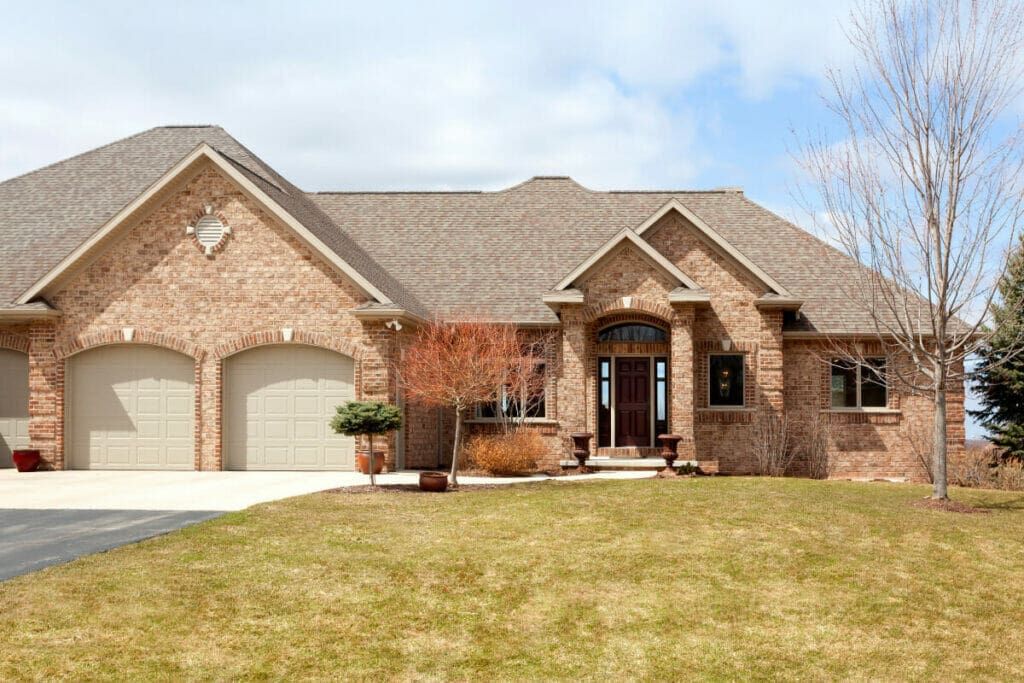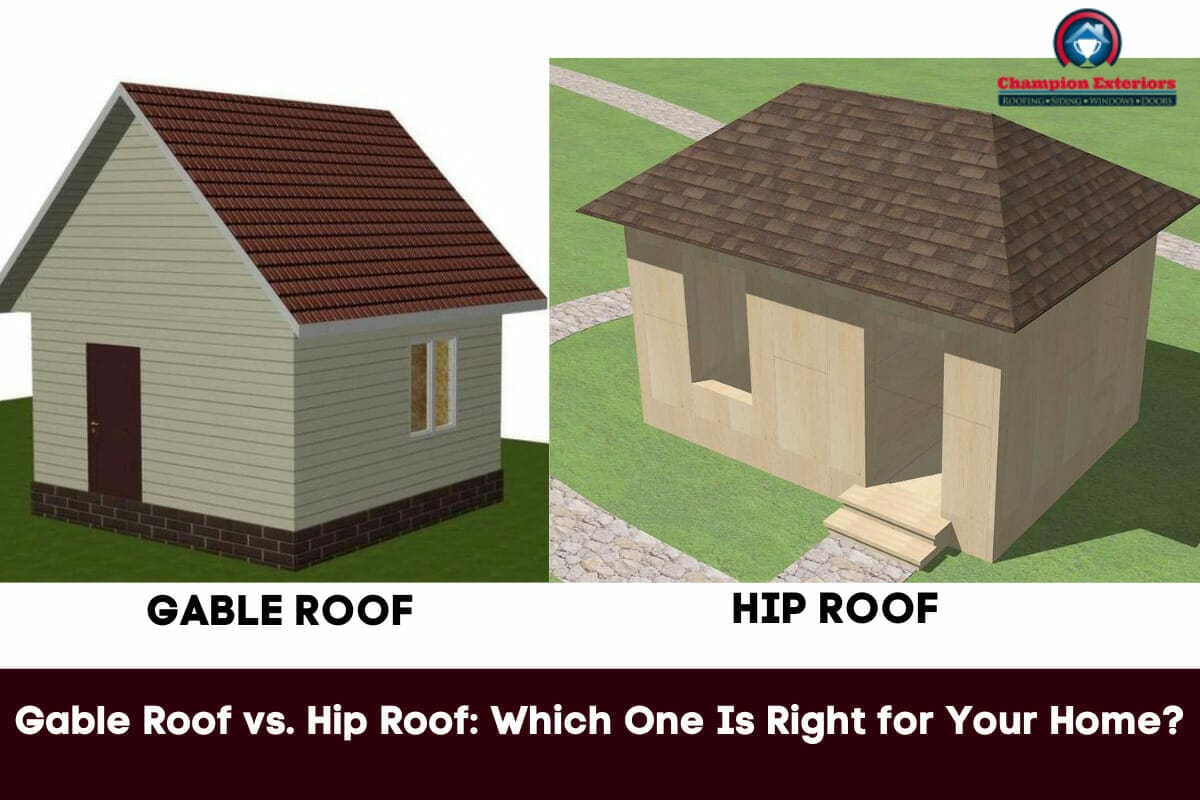If you are confused about whether to install a gable roof or a hip roof on your building, this blog post can make your life easy. This post critically compares gable roofs vs. hip roofs and will provide you with the information you need to choose the right one for your home.
What Is a Gable Roof?
Gable roofs are among the most popular types of roofs in the United States. Their popularity is due to their easy design and installation. A gable roof is a type of roof design that has two sloping sides that meet at the top to form a ridge or peak. The two sides, or “gable ends,” are typically symmetrical and create a triangular shape on either end of the home. Since they are relatively easy to construct and maintain, gable roofs are commonly seen throughout neighborhoods.
As the steep pitch on the two sides of the roof allows for rain, snow, and debris to slide off easily, it makes a practical choice for areas with heavy precipitation. Gable roofs can also be customized with different materials and colors to create a unique look.

What Is a Hipped Roof?
A hipped roof is a roof design that slopes downwards on all sides, creating a ridge or peak at the top. Unlike a gable roof, which has only two sloping sides, a hipped roof has four sloping sides. Additionally, gable roofs are more complex in shape, with no vertical gable ends. Each side of the roof features a downward slope or hip that runs from the ridge to the eaves. This design offers several benefits, including increased stability in high winds, as the sloping sides reduce pressure on the walls of the building.

Gable Roof vs. Hip Roof
The following sections compare hip vs. gable roofs and will help you pick the right roof for your home or business.
1. Construction and Design Differences
As mentioned above, a gable roof comprises two sloping sides, forming a peak or ridge at the center. Due to its simple construction and fewer materials requirements, a gable roof makes a cost-effective option. Additionally, gable roofs typically require less time and labor to construct compared to hip roofs. However, they are more prone to wind damage due to their shape, which can create uplift and pull on the roof.
On the other hand, a hip roof has four sloping sides that meet at the center, making it more complex to construct and requiring more materials. Although it takes more time and labor to construct, hip roofs are more stable in high winds due to their shape, making them suitable for areas with high winds.
2. Gable Roofs Have a Steeper Roof Pitch
Generally, because of their steep pitch, gable roofs rise higher in the center and slope downward more sharply. Their steeper pitch also makes them more suitable for areas with heavy snowfall, as the snow is less likely to accumulate on the roof. In contrast, hip roofs have a less steep pitch, typically ranging between 3:12 and 6:12, which creates a more gradual slope.
Also, read our article, do roof slopes affect the installation?
3. Durability of Materials
While both types of roofs can be durable when constructed properly, hip roofs tend to be more resilient in severe weather conditions due to their design. The sloping sides of a hip roof provide more support against high winds, which reduces the risk of damage to the roof and the rest of the home. In contrast, gable roofs are more susceptible to damage from high winds because of their shape, which creates more pressure on the walls of a building.
4. Difference in Attic Space
The attic in any home is the additional space under a roof. Due to their steep slope and classic architectural design, gable roofs allow for more attic space than hipped roofs. This is also the reason that gable roofs are found to be cost-effective and energy efficient.
Hip roofs are more complex than gable roofs and are often designed for larger homes. You’ll also find them on colonial-style, and Georgian-style buildings due to their aesthetic appeal with multiple slopes. One disadvantage of hipped roofs, however, is that they provide relatively less attic space.
5. Hip Roofs Are More Aesthetically Pleasing
Aesthetics are another important factor to consider when choosing between a gable and hip roof. Gable roofs have a classic and traditional look, which makes the home aesthetically pleasing and provides ample curb appeal. On the other hand, hipped roofs are more complex architecturally, as they’re designed mainly for bungalow homes. They create a sleek, and more contemporary look when properly installed.
6. Ventilation
Are you also considering the installation of energy-efficient ridge vents for your home? The vents installed on top of a roof help warm air escape a building while allowing for cool air to replace it. By promoting continuous airflow inside a home, vents keep the home cooler and energy efficient.
Roof ventilation differs between gable and hip roofs primarily due to their architectural design. Gable roofs, with their simple design and ample attic space, are well-suited for roof ventilation systems such as soffit and ridge vents. On the other hand, hipped roofs are more complex, with multiple faces that can make installing roof vents challenging and often ineffective. Additionally, since hipped roofs lack the vertical peak of gable roofs, installing ridge vents to increase airflow is limited at best. As a result, ventilation systems for hipped roofs may require alternative strategies to ensure adequate ventilation.
7. Different Levels of Water Resistance
Hip roofs and gable roofs differ in water resistance primarily due to their architectural design. Gable roofs have a simple, triangular shape that makes them naturally resistant to water intrusion. Rainwater slides down the steep slopes and is directed away from the roof’s edges, preventing water buildup that can lead to leaks. In contrast, hip roofs have multiple slopes that converge at the roof’s hips, which can make them more susceptible to water infiltration if not properly designed and installed. However, hip roofs with adequate flashing, gutters, and other waterproofing measures can provide excellent water resistance, making them a popular choice for coastal and rainy areas.
8. Hip Roofs Are Cost Expensive
Cost is an important consideration when buying a gable or hip roof for your home. The cost of installing a roof generally depends on many factors, including the roof size, the job’s complexity, the amount of labor involved, the skill levels of the roofers, and more. However, the cost to install a gable roof is comparatively lower than that of a hipped roof. Because of their simple and easy design, gable roofs are more cost-effective than hipped roofs in the long run.
Hipped roofs, as we know, are harder to install and require more materials and labor to deploy, which makes their installation cost higher.
Factors To Consider When Choosing a Roof Type
Many factors will influence the decision on which style of roof to choose for your building. You need to consider each:
Climate: If you live in an area with high winds or heavy snowfall, a gable roof may be a better choice due to its ability to shed snow.
Aesthetics: Gable roofs may be a better fit for homes with a more traditional or classic design, while hip roofs can be a good choice for modern or contemporary homes.
Cost: As mentioned above, gable roofs are typically less expensive to construct due to their simple design and require fewer materials.
Durability: Hip roofs are generally more durable and stable in high winds, while gable roofs can be more prone to damage in severe weather.
Ventilation: Gable roofs have a triangular shape that creates a natural flow of air and allows for the easy installation of roof ventilation systems, such as ridge and soffit vents.
Attic Space: If you are looking for additional living or storage space in your attic, a gable roof may be a better choice due to its shape and the additional space it provides.

Which One Is Better?
It’s important to note that neither gable or hip roofs are objectively “better” than the other. Each roof type has its own unique benefits and drawbacks, and the best choice will depend on your specific needs and preferences.
For homes in areas with high winds and heavy snowfall, a hip roof is better for its ability to resist wind and other extreme weather. But if you are limited in budget and seek more attic space, and better ventilation, a gable roof will work for you.
Hire Professionals To Install the Desired Roof on Your Building
If you want to install a durable and long-lasting roof on your home or office, you need to hire trusted and experienced professionals. Call Champion Exteriors today at (609)-845-3576 for a free consultation with our experts. Our team is proficient at handling all roofing and exterior projects, so give us a call today!


